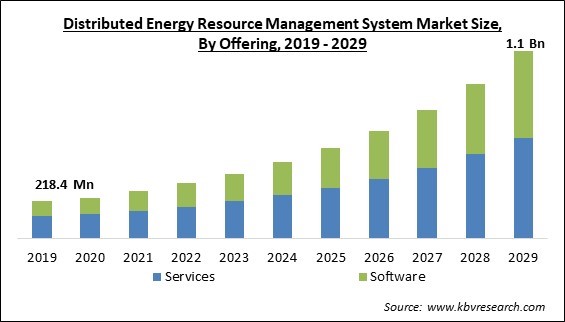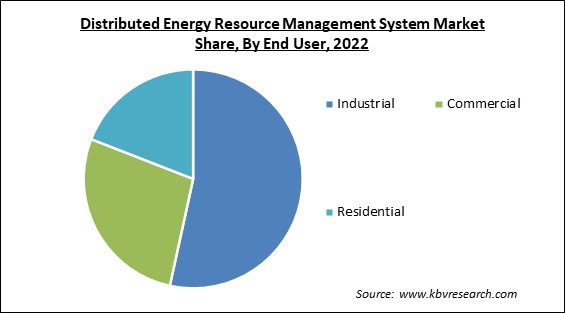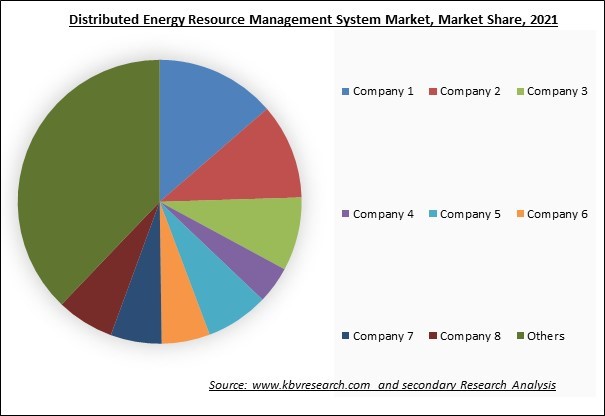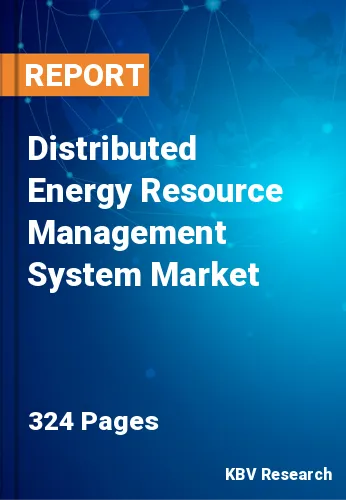The Global Distributed Energy Resource Management System Market size is expected to reach $1.1 billion by 2029, rising at a market growth of 19.4% CAGR during the forecast period.
Management and control segment is one of the software types utilized in DERMS that aids in administering the DER to regulate operations, promptly pinpoint errors, and implement the necessary corrective action. This software and tools also help planners identify different factors, which increases productivity and makes use of visual datasets. Therefore, it is expected to generate more than 35% share of the software segment by 2029. In addition, DERMS software contributes to grid resilience by enabling islanding and microgrid capabilities. In a grid outage or emergency, DERMS can autonomously isolate and operate a section of the grid using local DERs, ensuring continuity of power supply to critical loads. Some of the factors impacting the market are globally increasing demand for electric vehicles (EV), rising governmental efforts to deploy the smart grid, and increased initial installation fee for distributed energy resource management systems.

As more individuals have become concerned about the potentially catastrophic implications of climate change, a significant demand for EVs has grown. This is further impacted by the dreadful pollution levels observed in the world's largest cities, which are still increasing. In the ensuing years, the market would expand as a result. The connection between demand from consumers and the accessibility of renewable energy can be optimized with the use of smart grids. By ensuring that power is saved when it is accessible and affordable and released when demand increases, they may also use the possibility of energy storage.
However, deploying a distributed energy resource management system initially requires a significant outlay of funds. Changing infrastructures requires the involvement of both local and federal administrations. Therefore, all these factors may hamper the deployment of DERMS for many end users, which will slow down the market's growth.
By end user, the distributed energy resource management system market is categorized into industrial, commercial and residential. The commercial segment recorded a substantial revenue share in the distributed energy resource management system market in 2022. Distributed generation in commercial buildings refers to energy production that takes place on-site and off-grid. This often consists of power produced by renewable energy systems, including small wind turbines and solar photovoltaics (PV). Commercial buildings consume more energy than residences and are subject to price structures that penalize them during peak consumption hours.

Based on offering, the distributed energy resource management system market is segmented into software and services. The services segment garnered the highest revenue share in the distributed energy resource management system market in 2022. DERMS services offer a range of benefits, including improved grid reliability, enhanced integration of renewable energy, increased energy efficiency, demand response capabilities, and real-time monitoring and control. By leveraging these advantages, DERMS supports the developing of a more resilient, flexible, and sustainable energy infrastructure.
By software type, the distributed energy resource management system market is fragmented into analytics, management & control, and virtual power plant (VPP) software. The virtual power plant (VPP) software segment acquired the largest revenue share in the distributed energy resource management system market in 2022. The growth of the segment is owed to the widespread use of this software. A VPP has a wide range of characteristics, including features like utilizing cloud-based real-time operational management to cluster the capacities of various DERs to increase efficiency and trading power, making it a desirable alternative for end users.

The leading players in the market are competing with diverse innovative offerings to remain competitive in the market. The above illustration shows the percentage of revenue shared by some of the leading companies in the market. The leading players of the market are adopting various strategies in order to cater demand coming from the different industries. The key developmental strategies in the market are Partnerships & Collaborations.
On the basis of application, the distributed energy resource management system market is divided into solar PV units, wind generation units, energy storage systems, combined heat & power generation systems, EV charging systems, and others. The solar PV units segment witnessed the maximum revenue share in the distributed energy resource management system market in 2022. In order to regulate and enhance the capabilities of solar energy generation, DERMS are used. The widespread adoption of DERMS in the solar sector and the extensive use of rooftop solar panels have contributed to the importance of solar applications in the market. In addition, DERMS facilitates the integration of energy storage systems with solar PV units.
| Report Attribute | Details |
|---|---|
| Market size value in 2022 | USD 321.6 Million |
| Market size forecast in 2029 | USD 1.1 Billion |
| Base Year | 2022 |
| Historical Period | 2019 to 2021 |
| Forecast Period | 2023 to 2029 |
| Revenue Growth Rate | CAGR of 19.4% from 2023 to 2029 |
| Number of Pages | 324 |
| Number of Table | 460 |
| Report coverage | Market Trends, Revenue Estimation and Forecast, Segmentation Analysis, Regional and Country Breakdown, Market Share Analysis, Companies Strategic Developments, Company Profiling |
| Segments covered | Offering, Application, End User, Region |
| Country scope | US, Canada, Mexico, Germany, UK, France, Russia, Spain, Italy, China, Japan, India, South Korea, Singapore, Malaysia, Brazil, Argentina, UAE, Saudi Arabia, South Africa, Nigeria |
| Growth Drivers |
|
| Restraints |
|
Region wise, the distributed energy resource management system market is analysed across North America, Europe, Asia Pacific and LAMEA. The Asia Pacific segment witnessed the largest revenue share in the distributed energy resource management system market in 2022. This is a result of escalating environmental concerns, government programs to promote solar panel installation, as well as tax benefits, along with technological developments that reduce production costs and increase solar panel manufacturing efficiency. To hasten the development of new energy sources and meet its carbon reduction goals, China is expanding distributed solar power capacity.
Free Valuable Insights: Global Distributed Energy Resource Management System Market size to reach USD 1.1 Billion by 2029
The market research report covers the analysis of key stake holders of the market. Key companies profiled in the report include Siemens AG, Schneider Electric SE, General Electric Company, Hitachi, Ltd. (Hitachi Energy Ltd.), Emerson Electric Co., Mitsubishi Electric Corporation, Oracle Corporation, Itron, Inc., Generac Holdings, Inc. and Enel S.p.A.
By Offering
By End User
By Application
By Geography
The Market size is projected to reach USD 1.1 billion by 2029.
Rising governmental efforts to deploy the smart grid are driving the Market in coming years, however, Increased initial installation fee for distributed energy resource management systems restraints the growth of the Market.
Siemens AG, Schneider Electric SE, General Electric Company, Hitachi, Ltd. (Hitachi Energy Ltd.), Emerson Electric Co., Mitsubishi Electric Corporation, Oracle Corporation, Itron, Inc., Generac Holdings, Inc. and Enel S.p.A.
The expected CAGR of this Market is 19.4% from 2023 to 2029.
The Industrial segment is leading the Market by End User in 2022 thereby, achieving a market value of $571 Million by 2029.
The Asia Pacific market dominated the Market by Region in 2022 and would continue to be a dominant market till 2029; thereby, achieving a market value of $409.5 Million by 2029.
Our team of dedicated experts can provide you with attractive expansion opportunities for your business.

